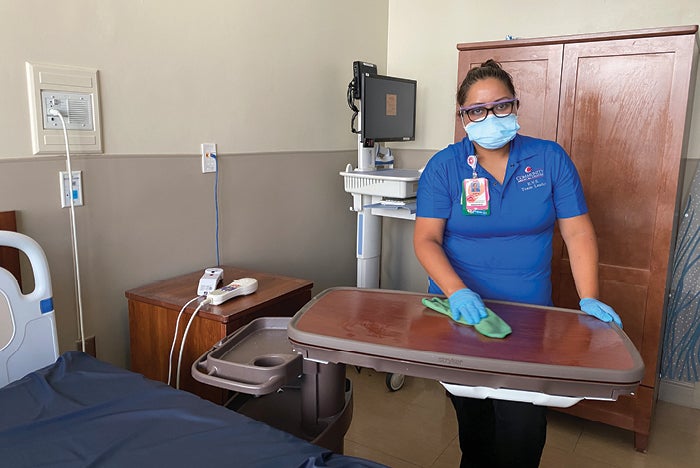Certification boosts EVS knowledge and satisfaction

EVS team lead Joanna Vasquez says she’s able to share what she’s learned in obtaining CHEST certification with peers.
Image courtesy of Community Medical Centers
Community Medical Centers, part of Community Health System in Central California, launched its new environmental services (EVS) “tech 2” position as an opportunity to build its EVS staff’s expertise in disinfection best practices, while also creating a new opportunity for staff to advance professionally.
This higher-level position offers EVS staff potential to grow, says Casey Jenson, manager of EVS at Clovis (Calif.) Community Medical Center. “It used to be just tech, team lead and then supervisor, so there was not a lot of growth potential unless a leader left,” Jenson says.
This new position is contingent upon earning the Association for the Health Care Environment’s (AHE’s) Certified Health Care Environmental Services Technician (CHEST) certification. Eleven members of the Community EVS team have since met that challenge, ranking among 379 CHEST-certified health care EVS techs in California and 5,244 certified EVS technicians nationwide.
The team members spent 10 weeks studying CHEST modules that outline best practices for cleaning and sanitizing in a health care facility in preparation for taking the two-hour exam in July. Since the pandemic’s onset, AHE has offered virtual workshops to cover the certification’s required 24 hours of classroom instruction.
Data collected by AHE, which is a professional membership group of the American Hospital Association, indicates that hospitals with certified EVS techs report a 10% improvement in patient experience on HCAHPS scores, and help reduce hospital infection rates by more than 50%. However, Community Medical Centers has also found certification helps boost EVS employee satisfaction by demonstrating an investment in staff members’ education and professional development.
“I think this shows our staff that we want them to grow — that we believe they can do work that matches the level of national best practices,” Jenson says.
Having team leads well versed in these best practices also can provide a trickle-down effect, as EVS team members are able to disseminate best practices learned through CHEST certification to the rest of their team.
“I’m able to pass on what I learned in the classroom to my co-workers and correct them when they are not doing something right,” says Joanna Vasquez, an EVS team lead at Community Regional Medical Center, Fresno, Calif. “And not only correct them, but also tell them that this is the reason why we’re doing it this way.”


